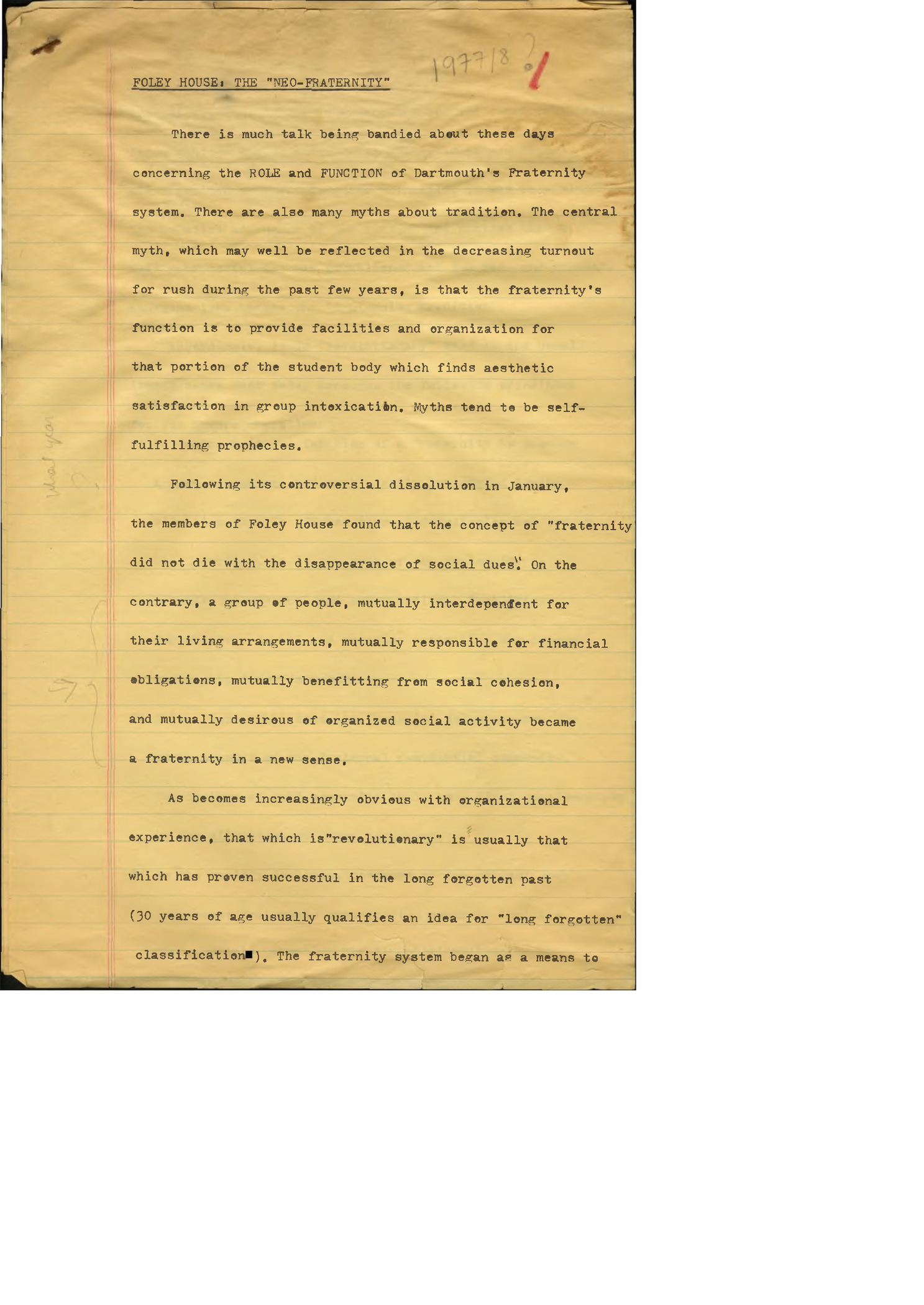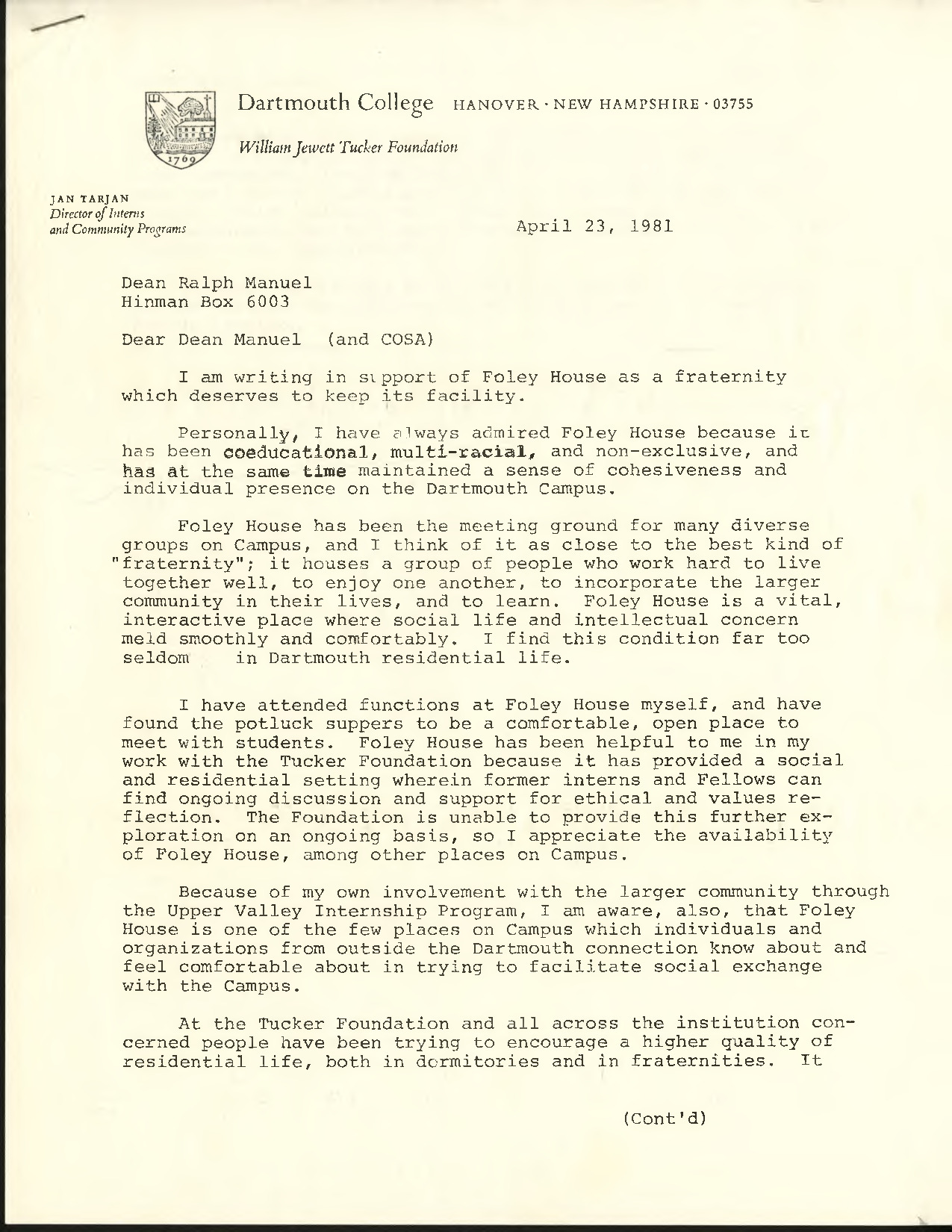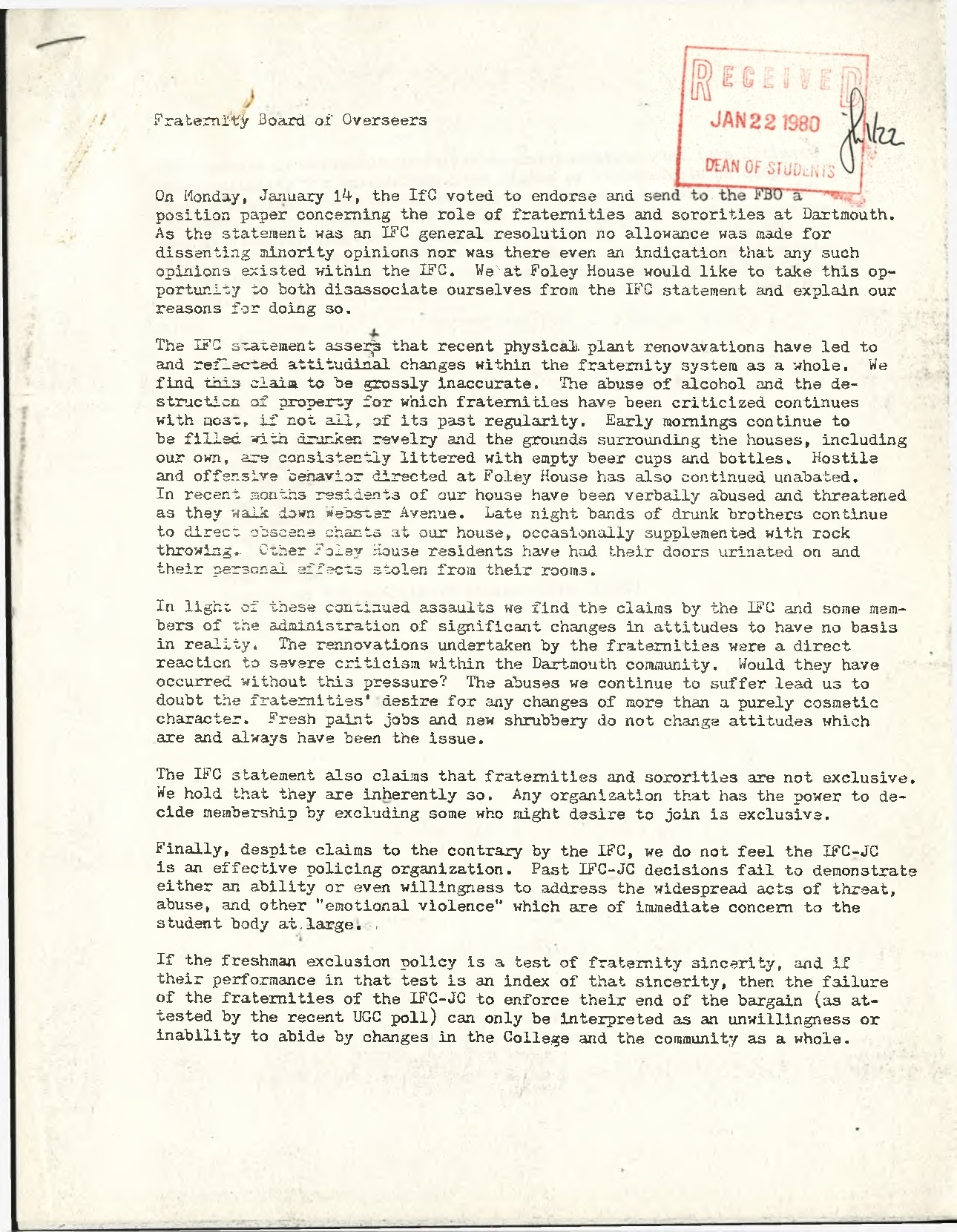Foley House: A Case Study for Alternative Social Spaces
“We feel what we have done as a house speaks for itself (in terms of upkeep, sexual/racial integration, community involvement, group accomplishments). We also feel that Foley House, unlike some other houses–will survive this controversy because the fundamental accusations of Epperson do not apply to our arrangements. It seems likely Foley House will serve as a model for viable alternatives to the frat system.”[1]
In 1978, Foley House members felt that Epperson’s charges levied against the fraternity system couldn’t be applied to them, since their house rejected the image of a traditional Dartmouth fraternity.
“Foley House is still an anomaly on ‘the row.’ It’s the only place where sisters and brothers coexist in co-operative, egalitarian, productive and non-alcohol centered fashion, at the fraternal center of campus. Foley House is a prominent and longstanding reminder to the community that, ‘it is not necessary to abuse alcohol to have a good time!’
McLaughlin, R. Sean ‘79, “Letter to President McLaughlin.” 1982/3, DA-794, Box 8287, “Alcohol Concerns: Correspondence, 1982-83,” Dartmouth College, Student Activities records, Rauner Special Collections Library, Hanover, NH
The physical plant of Foley House had existed as Epsilon Kappa Phi since 1920. In 1926, the house became a chapter of the national corporation Delta Upsilon, and then in 1966 the house once more went local, adopting the name Foley House after one of the initial founders Al Foley. By the late 1960s, Foley House members had a distinct counter-culture attitude. In 1969, Foley House gave bids to two co-ed transfer students–three years before Dartmouth itself went fully co-ed. In 1971, Foley House faced such financial difficulty that the fraternity was forced to disband–this lasted unil 1974, when Foley House was reestablished with a fraternity constitution. This is all to say that by the Epperson proposal vote, Foley House had seen a lot of change.
Then, in 1977, just as Foley House was hitting a new stride, treasurer of the Delta Upsilon chapter at Dartmouth (the owners of Foley house) asked the College to buy Foley. Treasurer Robert Finney wrote: “Frankly, I think the corporation is tired of writing checks for a place that's essentially a boarding house. The corporation received a charter from New Hampshire in 1920, and I don’t think we’re meeting the spirit of that charter, and may not even be meeting its legal requirement that we maintain a fraternal situation.”[2] Thus ensued a multi-year long battle to keep Foley House on Webster Ave, where Foley residents had to address the charges of ‘underutilization’ and the lack of ‘fraternal’ character. As part of this process, Foley House had to make its claim to the Dartmouth community about the contrast that Foley offered to the traditional Greek system.
Students on campus would have known Foley House as an alternative social space that rejected the ‘beer and band’ model for socializing set forth by other Dartmouth fraternities. Some of the regularly occurring events at Foley House included the Foley Food Co-Op, a dining cooperative that served faculty, administration, and students more affordably than Thayer Dining Hall. Foley hosted the Dartmouth Women’s Association’s “Rabbit’s Luck” coffeehouse, a social event that brought students together through folk music and non-alcoholic beverages. Foley was also host to meetings for the women’s societies, the gay-straight alliance, and left-wing political organizing groups.
Foley House paid a price for subverting the fraternity tradition of exclusivity on the basis of gender and sexuality. Foley House members recount assaults like rock throwing, derogatory chants and frequent burglary. Famously, fraternity men would line up in front of Foley House and send golf balls through the windows of the house in an event affectionately named the “Foley Open.”
“It seems to me ironic that the one house which might be successfully abolished is among the very few for whom Epperson’s criticism did not import great changes. Foley House is not sexist, alcoholic, anti-intellectual or subject to bouts of vandalism. I refer you to the attatched letter from the college chaplain as a less biased defense of Foley’s importance to the college than I could give. I cannot help but sense that the present attack on Foley has for some of the administrators and trustees an unstated, more ideological motivation. It is not secret that Foley is seen by some as antithetical to the ‘old traditions.’”
Sharp, Paula. "Paula Sharp letter in support of Foley." DA-670, Box 10015, "Foley House Meeting Minutes (1981)," Office of Residential Life Records, Rauner Special Collections Library, Hanover, NH.
In order to defend their claim to 9 Webster Ave, Foley Residents gathered 427 signature in support of keeping Foley House on ‘the row.’ Numerous humanities departments signed letters claiming that Foley House existed in the tradition of “Plato’s Academy of Bloomsbury,” where artists and thinkers lived together.[3] These efforts bought Foley House a few more years on the row. Despite growing membership numbers and improved communication with college administrators, Foley House eventually changed designation from ‘fraternity’ to ‘affinity house.’ The Foley House community was moved off campus to make room for a sorority on 9 Webster Ave., satisfying many alumni wishes that a sorority exist on Webster Ave to dilute the male monopoly on the ‘row.’
[1]Foley notes on IFC response to Epperson, DA-670, Box 10015, "Interfraternity council and fraternity board of overseers papers," Office of Residential Life Records, Rauner Special Collections Library, Hanover, NH.
[2]Levinger, Jeff. "Corporation asks College to Buy Foley House." The Dartmouth (Hanover, NH), May 6, 1977, Rauner Special Collections Library, Hanover, NH.
[3]1981 Humanities departments letters supporting Foley, April 21, 1981, DA-670, Box 10015, "Foley House meeting minutes (1981)," Office of Residential Life Records, Rauner Special Collections Library, Hanover, NH.
From the Archive
Click on an image to access the full document, audio-visual components, and/or metadata associated with that item.

In this document, the Foley House mission was described as providing a viable social alternative to the traditional Dartmouth fraternity. The Foley model emphasized community-forming and financial inclusivity.
 Historical Accountability Student Research Program
Historical Accountability Student Research Program


